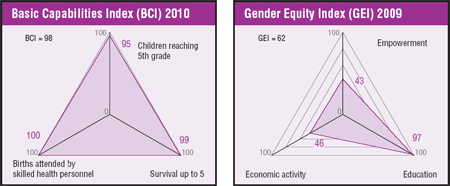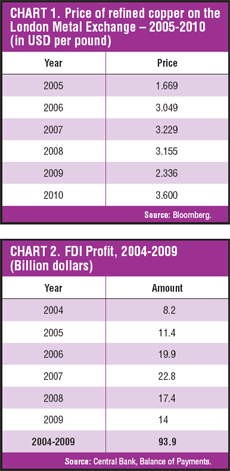No sustainable development without fair taxation
Centro de Estudios Nacionales de Desarrollo Alternativo (CENDA)
Hugo Fazio
Chile not only has one of the most unequal distributions of income in the world, but is also highly dependent on the export of prime materials, putting it at the mercy of fluctuations in international markets. However, the Government’s only development strategy is to facilitate conditions for the expansion of capital and investment in natural resource exploitation. This includes tax incentives for private mining enterprises in an already regressive taxation system. The top priority should be a development strategy that allows wealth to be redistributed in a more equitable way. To do this the country must first completely overhaul its unjust tax system.
 |
The Chilean economy is fraught with distortions of different kinds, in part because financial capital is allowed to circulate freely. The inflow or outflow of capital has big repercussions on economic activity and the balance of payments, and under a free flow of financial capital national budgets are determined by changes in international markets and not geared to development strategies or policies. In recent years, however, the financial sector in Chile has been less attractive than elsewhere in the region for foreign investors because of its low interest rates and narrow profit margins.
The country does not have a policy to finance development as such; rather it has a series of measures aimed at attaining specific objectives such as making benefit payments, but these are still completely inadequate.
Chile is among the 20 countries with the most unequal income distribution in the world. There is structural unemployment, small enterprises are suffering the consequences of economic opening, and this has been exacerbated in recent years by the increased value of the currency on foreign exchange markets. Poverty rates are far above what official statistics show, as has been clearly shown in studies published by the current Treasury Minister, Felipe Larraín.[1] Therefore what the country needs is an effective economic and social development strategy that is adequately financed.
Great dependence on markets
Chile is above all an exporter of prime resources. A look at the 2009 figures for the biggest export enterprises shows that once again sales to other countries consist mainly of prime materials or products with scant added value. There are more export destinations now, and more Chilean enterprises are involved, but the products are basically the same and different categories may increase or decrease its share in response to prices on international markets. Chile has signed numerous trade agreements, but these have not changed this basic profile. In 2009, the mining sector accounted for 58.1% of exports, and copper alone made up 52.4% of the total. This structure is clearly deformed, and it will have to be changed.[2]
This scenario makes it obvious that the Government will have to turn to copper for its development resources, and doing so requires policies that are geared to the national interest. In every year since 2006 (except 2009) copper prices on international markets were extraordinarily favourable, and everything points to this trend continuing in 2010.
 |
Tax incentives
Who directly receives these huge incomes? Exporting enterprises that are mostly private and mostly foreign control more than 70% of the copper extraction sector, and the State enterprise Codelco accounts for the rest. The high price for this metal in recent years has meant very good profits indeed for these private consortiums.
However, even though these enterprises are exploiting deposits that belong to the Chilean people the taxes they pay on their profits are extremely low, about 4%, a figure set by agreement with the private consortiums. Moreover, for years taxation levels have been fixed by agreement, which amounts to the Government renouncing its sovereign rights.
In May 2010, the Government of Australia announced that it would impose a 40% tax on the profits of enterprises exploiting the natural resources of that country. Marius Kloppers, executive director of BHP Billiton – the enterprise that is exploiting the world’s biggest copper deposits in Chile – stated that this measure would mean that the effective tax rate on the enterprise’s operations in Australia would go up by 43% to around 57% in 2013. This is more than three times greater than the rate levied in Chile.[3]
If there is to be development in Chile, the excessive profits the private copper consortiums are making in the country should stay in the country. This was the logic behind how net payments to US transnational enterprises were estimated at the time when copper was nationalized under the Popular Unity Government in line with the so-called “Allende doctrine.” Such a measure today would generate enormous resources for the country.
The utilization of resources
High prices for copper on international markets have also meant that tax income from this sector has risen,[4] and the way these resources are allocated says a lot about the country’s situation. Public expenditure accounts for funds received up to the estimated level derived from copper price trends, which is calculated on the basis of the average price up to a horizon of ten years. Income above this level generated a tax surplus which was placed in financial assets abroad. During the Michelle Bachelet administration these funds amounted to more than USD 20 billion and in 2009 they were used exclusively to finance the fiscal deficit. This deficit was incurred through increased public spending in an attempt to counteract the recession that hit the Chilean economy in mid 2008, and to compensate for reduced income caused by the fall in the levels of economic activity.[5]
In March 2010, the country had USD 14.5 billion in sovereign funds placed abroad. Of this total, some USD 3.4 billion was earmarked for a specific purpose, the Reserve Benefits Fund. The remaining USD 11.1 billion was placed in the so-called Economic and Social Stabilization Fund (FEES in Spanish) and was available for use. Chile was struck by an earthquake and seaquake at the end of February and since then there has been a severe emergency situation, but up to now the funds have not been used even though they exceed the USD 8.4 billion over four years, which is the figure the Government estimated the public sector would allocate to repair the damage caused by the earthquake. If the official calculation of public needs is taken as a reference, the resources currently in the FEES could be used immediately to alleviate the situation.[6]
This conclusion is even more inescapable when we consider that resources had also been accumulated in line with the so-called Reserved Copper Law, whereby 10% of the proceeds from sales made by the State copper enterprise Codelco are allocated to purchasing armaments; with the high price of copper this generated a surplus, as income from Codelco regularly exceeded the level of expenditure specified for these purchases in the annual budget law.[7] If the price of copper remains high this will generate several billion dollars in income above what was anticipated when the 2010 budget was drawn up.
A regressive tax system
What route did the Government of Sebastián Piñera decide to take? It promoted a “voluntary” tax increase on the reduced levy that is paid - depending on operational results – by the copper enterprises, which had already been benefiting from the fixed-rate tax mechanism for two years. This plan provides for a prize for enterprises that opt to take advantage of it, and this in effect prolongs the fixed-rate mechanism until 2025, which amounts to extending the period in which the country’s sovereignty is violated.
It is clear that this system in no way generates finance for development; it is merely perpetuating the pillage of the country’s natural resources because the foreign enterprises send a high proportion of their profits abroad. To make matters worse, the Chilean economic group involved in the large copper enterprise (Luksic) is using a part of its extra income to expand internationally.[8]
It is for these reasons that Chile needs to completely overhaul its tax structure. The present system is clearly regressive in that it is based primarily on indirect taxes, especially the value added tax (VAT), whereby the burden is spread indiscriminately across the population as a whole. If the Government is to be able to finance a national development policy it will have to implement tax reform geared to retaining the big copper enterprises’ excessive profits in the country – and putting an end to their fixed-rate tax advantages – and also to reorganizing the tax situation for shareholders in the big enterprises so as to prevent indirect evasion in the form of credits against taxes on profits and discounts on personal taxes, both of which are features of the current system.
The extent of the problem and the Government’s response
The sheer magnitude of the resources taken out of the country every year can be seen from the balance of payments figures. Since 2004, some USD 93.9 billion has left the country as the profits of foreign direct investment (FDI). Obviously, the amounts vary from year to year, depending on prices in the international markets for exported prime materials. The peak years were 2006 and 2007 when the cost of copper soared to unprecedented levels, and in 2007 the amount remitted abroad reached a record of nearly USD 23 billion. All of this goes to show that Chile has the potential to finance a national development policy, but this will have to be based on far-reaching changes and accompanied by suitable social policies.
However, the Sebastián Piñera Government has not taken this path. According to the Minister of Mining, Laurence Golborne, the administration’s main concern is to raise investment in the mining sector, even though this means weakening controls on the conditions under which resources are exploited, and keeping enterprise taxes low. In May 2010, Golborne stated: “We are facing a gigantic challenge. The investment plan for mining amounts to USD 45 billion. Today 5.4 million tons of copper are being produced and in 2020 we will be producing 7.5 million, which is a 50% increase in production.”[1] The problem is that if the legal framework is not changed this would only mean that the country’s resources are being pillaged on an even larger scale by the private sector.
Golborne does not foresee the same levels of investment growth in the State mining enterprise. According to the Government, rather than allocating some of the Codelco surplus to its investment plans, its first priority is reconstruction and the State enterprise can obtain resources, either through incurring debt or by selling off non-essential assets. Chile needs a national policy for the copper sector, in particular with respect to Codelco, which would take on the key role in an adequate national development strategy.
[2] Central Bank, “Boletín mensual, abril de 2010.” Available from: <www.bcentral.cl/publicaciones/estadisticas/informacion-integrada/pdf/bm042010.pdf>.
[3] El Mercurio, citing The Financial Times, 3 May 2010.
[4] Dirección de Presupuestos (Budget Management Office).
[5] Ibid.
[6] Ibid.
[7] Reserved Copper Law and Budget Authority.
[8] See Hugo Fazio, “La crisis mundial modifica el mapa de la extrema riqueza,” Centro de Estudios Nacionales de Desarrollo Alternativo (CENDA), 2010.
[9] La Tercera, 8 May 2010.


